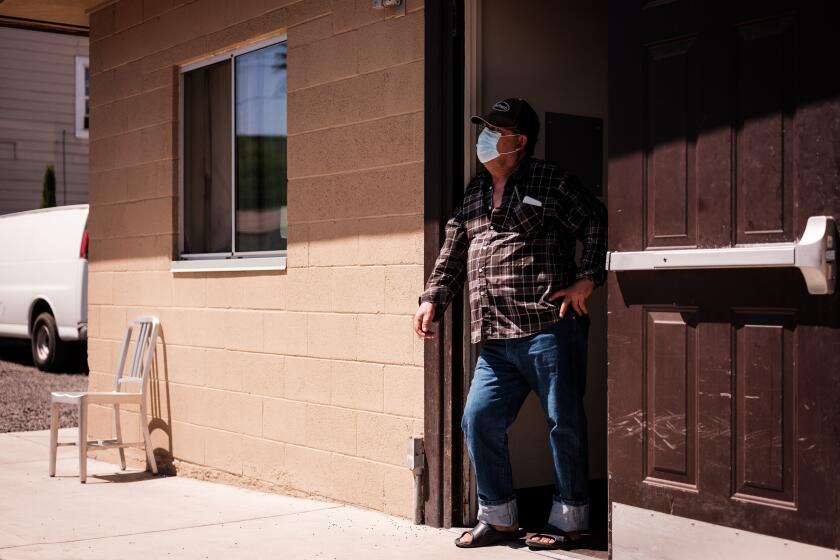California adds COVID-19 equity requirement. It could trip up counties’ reopenings

- Share via
California’s larger counties will not be permitted to reopen their economies further unless they reduce coronavirus infections in the hardest-hit places where the poor, Black people, Latinos and Pacific Islanders live.
Under a new state requirement for reopening during the pandemic, counties with more than 106,000 residents must bring infections down in these places and invest heavily there in testing, contact tracing, outreach and providing means for infected people to isolate. Los Angeles is one county sure to be affected, along with others in Southern California.
The measure is designed to ensure that test positivity rates in the most disadvantaged neighborhoods do not significantly exceed a county’s overall rate, a disparity that has been widespread during the pandemic.
The new requirements, which take effect Tuesday, may make it difficult for some counties to reopen as quickly and broadly as local leaders would like.
Black people, Latinos and Pacific Islanders have been disproportionately hurt by the pandemic. Many are essential workers, lack easy access to healthcare or live in crowded conditions. In San Francisco, at least half of all the the city’s infections stem from the Mission District, which is heavily Latino.
“Our entire state has come together to redouble our efforts to reduce the devastating toll COVID-19 has had on our Latino, Black and Pacific Islander communities,” the state’s acting public health officer, Dr. Erica Pan, said in a news release.
“This isn’t just a matter of higher cases in these communities — it is an issue of life and death that is hurting all Californians,” she said. “An all-community, cross-sector approach to work together to slow the transmission of COVID in all populations will help ensure we reopen our economy safely, protect our essential workers and support our local partners.”
It’s becoming increasingly clear that California is not going to conquer the coronavirus until it dramatically improves safety measures for essential workers at the epicenter of the health crisis.
State officials announced weeks ago that a new “equity” measure would be added. It was unveiled on the state’s Department of Public Health website Wednesday.
Most counties have significant differences in the coronavirus positivity rate between richer and poorer neighborhoods. The prevalence of disease in one neighborhood adds to the risks for the entire county, the state said.
“It is imperative to reduce disease transmission in all communities to ensure California reopens its economy safely,” the Department of Public Health said in announcing the new metric.
The larger counties’ census tracts will be divided into quartiles based on the California Healthy Places index, a measure of socioeconomic opportunity that takes into account economic, social, education, housing and transportation factors. The lowest quartile of these tracts is now home to 24% of Californians but accounts for 40% of COVID-19 cases, the state said.
In San Francisco’s Mission District, a community effort is helping Latinos and other low-wage workers who can’t afford to stay home and fear losing their jobs if they test positive for the coronavirus.
The requirement establishes specific positive case rate numbers that larger counties must meet in their poorer cities and neighborhoods to move to a less restrictive level of reopening. These counties also will have to submit plans targeting those communities for health investments.
Counties that fail to meet the new metric will not be moved to a more restrictive tier. They just won’t be able to advance in reopening.
The new metric also rewards counties that bring down disease in their low-income regions, making it easier for them to reopen even if they fall behind the two other state requirements now in place.
Those two requirements allow for reopening only if weekly new infections are no more than seven for each 100,000 residents and test positivity rates are at certain levels.
Heavily Latino communities in Los Angeles County have recorded the most confirmed cases of COVID-19. As of Thursday, health authorities had recorded 6,375 confirmed, reported cases of COVID-19 in East Los Angeles, according to The Times’ coronavirus tracker. By comparison, Glendale, with a higher population, has had 3,793 reported cases.
Los Angeles County did not immediately respond to an email Thursday morning asking about the potential effect of the new requirement.
The county Public Health Department on Thursday confirmed 35 new deaths and 1,148 new cases of COVID-19. Cumulatively, the county has identified 271,371 cases of COVID-19 and 6,610 deaths.
The county is now slowly reopening after failing to see a surge of new cases after the Labor Day weekend. Indoor nail salons were able to reopen at 25% capacity Thursday. Outdoor card rooms will be able to open without food and beverages Monday, and indoor shopping centers will reopen Wednesday at 25% capacity.
“We must be sure that every business or sector that is reopening complies with 100% of the safety directives,” said Barbara Ferrer, the county’s director of public health. “If the new reopenings result in increased community transmission, our recovery journey may need to slow down.”
San Francisco, which has worked for months to devote more resources to the heavily Latino Mission District, said it welcomed the new equity metric.
“As we have seen in San Francisco and across the state,” the city’s COVID Command Center said, “this virus exploits historic inequities and structural racism.”
In an email, the command center said San Francisco has invested extensively in “equitable emergency response,” offering free testing, free isolation and quarantine accommodations and an outbreak management program for vulnerable communities, among other programs.
San Francisco is now in the orange reopening tier, which means the spread of disease is moderate.
More to Read
Sign up for Essential California
The most important California stories and recommendations in your inbox every morning.
You may occasionally receive promotional content from the Los Angeles Times.
















